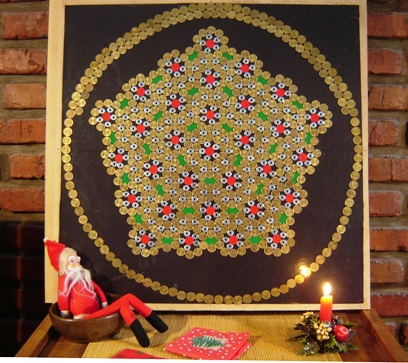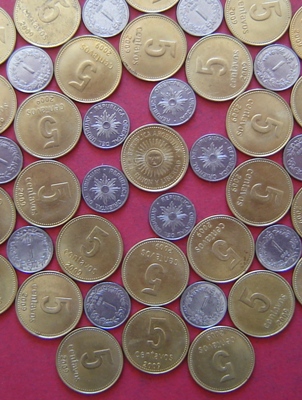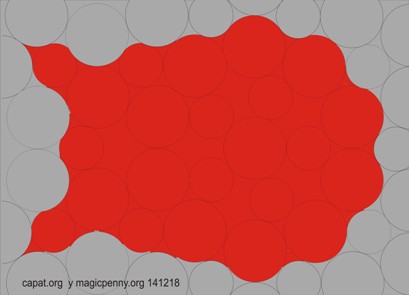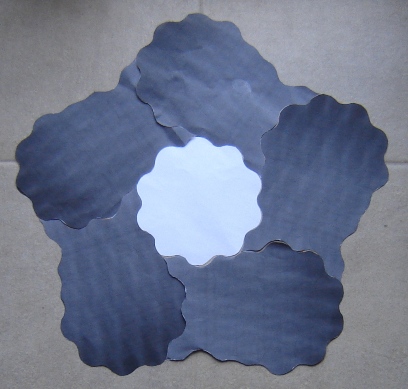Patagonia Pentagonal Rose Mandala "Francisco-Mujica"
- discovery of the Patanon "Patagon Gianton"
- uncovering 0.701301616704079...("patagonia pentagon" or "iron ratio")
- a versatile creativity stimulus in science, engineering, design and art -
|

|
|
1. Patagonia Pentagonal Rose mandala “Francisco-Mujica” (with common steel washers and current 5 centavo coins of Argentina)
|
|

|
|
2. Patagonia Pentagonal Rose mandala “Francisco-Mujica”. Detail during partial construction with 1 peso coins of Uruguay dated 1989.
|
|

|
|
3. Patanon "Patagon Gianton"
|
|

|
|
4. Five Patanons packed in a circle around a related central "curl-sided" decagon (see text)
|
|
2014 December 28
CAPat is celebrating the Festive Season and the coming New Year 2015 with this publication of details of the construction of the Patagonia Pentagonal Rose mandala "Francisco - Mujica" and the discovery of the Patanon. The uncovering of the number 0.701301616704079...and its significance as the "iron ratio" is also described.
The rose mandala has been so named, because it is made of small coins of Argentina and Uruguay, and because of the world-wide high regard for the humble nature of such distinguished persons of these countries.
"Patanon" is a general name given to a particular geometrical beetle-fish-like form that is based on a pentaganol array of circular objects of 2 distinct diameters one of which is approximately 70 percent of the other.
The forms can be packed together exactly, without leaving any gaps in two important ways:
a) in parallel lines with patanons in adjacent lines facing in opposite directions
b) in circles around a central 10 sided form with curled edges similar to that which forms a central part of each patanon (the patanons in adjacent lines again face opposite directions).
Because of these geometric properties patanons can cover exactly an infinite space.
The finding of “patanons” by CAPat and their relevance to science and art is the result of hands-on practical experiments, with magnetic coins made of iron (steel) which have been developed in Patagonia, Argentina.
The construction of the "Francisco-Mujica mandala rose is possible because the ratio of the diameters of the 1 peso coin of Uruguay dated 1989 (diam 12 mm) and the current 5 centavo coin of Argentina (17mm diam) is close to 0.7.
Using clasical geometry the theoretical ideal is 0.701301616704079.....
The existence of this number albeit to fewer decimal places has been known for centuries. Yet little or no attention seems to have been given to its significance.
In the light of the history of our uncovering it during experiments with magnetic coins made of iron, we are calling it the "Patagonia Pentagon" number or "Iron Ratio".
In practice, however, many will be pleased to know that no mathematics is required when working with patanons.
Related patanons and mandalas can be made using any two types of objects of different sizes provided the smaller object fits closely into a circular ring of 5 of the larger.
Similar mandalas have already been made with other coins and circular objects of suitable diameter.
In the latest 4th edition of "Investigating Magnetism" by Willson, Riley and Harris (2014), the fact that the diameters of the British 2p (26 mm) and the 5 p (18mm) make them ideal for the construction of pentagon arrays has been pointed out.
Another everyday example of suitable "iron ratio" couples are standard CD/DVDs and the lids of some everday jars of coffee. (120mm and 83.5 mm respectively).
The decoration of these objects and the construction of related patagonia triangles and doughnuts are already taking place. News of many more activities are awaited with interest.
|
|




